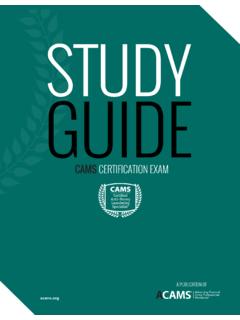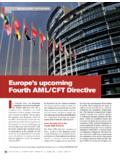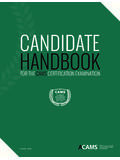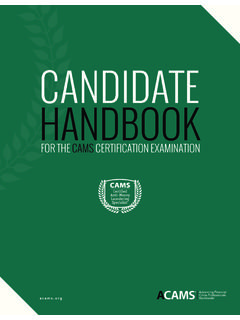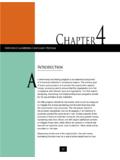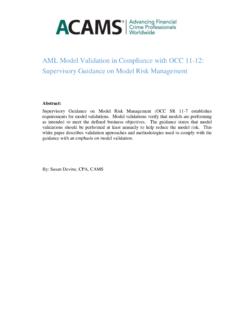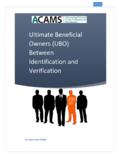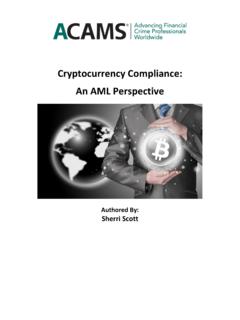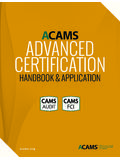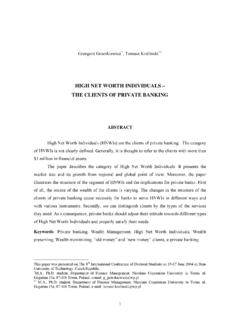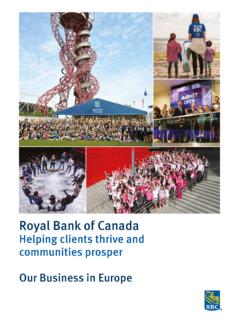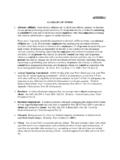Transcription of “The Risks of Banking with HNWIs” - ACAMS
1 The Risks of Banking with HNWIs An Effective Anti-Money Laundering Program for Wealth Management Abstract This white paper explains the Risks banks face when engaging with high-net- worth individuals (HNWIs) and how to implement an effective anti-money laundering (AML) program for wealth management and the program s specific components. Author Sahar Banu 2 | P a g e Executive Summary The World Wealth Report 2015 states that the robust economic and equity market performance enabled wealth to grow by about 7 percent and has helped create nearly a million (920,000) new millionaires globally in 2014.
2 This was the sixth consecutive year of growth for the high-net- worth market. Global HNWI wealth is projected to grow by almost 8 percent annually until 2017. The report found that the use of credit as a leverage for investments or equity financing in (HNWI portfolios is HNWIs have shown keen interest in investing their wealth in areas which will drive a positive social impact. They are actively seeking help from their investment advisors to structure their investment portfolio in such a way that it will have a perceivable and measureable impact on their social This growth in the economy has not only changed the economic risk factors, but has also affected the other macro environmental factors such as political, social, technological and legal risk influencing the finance industry.)
3 The dynamic risk environment has created the need for the implementation of an effective AML program for wealth management. The key components of an AML program are risk identification, mitigating measures and governance which should be defined with a primary focus on HNWIs. Proper governance is key to the success of any AML program. It is therefore important to stress the significance of AML by having top management explain the risk appetite to the organization. By doing this, a culture of compliance is created in the institution. The growing threat of organized crime and terrorism continues to challenge the financial sector.
4 Banks and financial institutions should ensure ongoing effectiveness of the AML program through periodic reviews and/or independent audits of the AML program. 3 | P a g e Contents 1. Introduction---------------------------- ---------------------------------------- ----------------------- 4 2. Background------------------------------ ---------------------------------------- ---------------------- 5 3. Components of the AML Program--------------------------------- ----- 6 Risk Identification-------------------------- ---------------------------------------- -6 Mitigating Measures-------------------------------- --------------------------------8 Governance------------------------------ ---------------------------------------- -----10 4.
5 Conclusion------------------------------ ---------------------------------------- ------------------------12 5. Glossary-------------------------------- ---------------------------------------- -------------------------13 6. Bibliography---------------------------- ---------------------------------------- ------------------------13 7. Annex (Case)---------------------------------- ---------------------------------------- ------------------14 4 | P a g e 1. Introduction Don t laugh, the piggy bank strategy works reads an article dated April 20, 2014 in USA While the chinese consider the piggy bank a good luck charm, Europeans see the piggy bank as a harbinger of good fortune and Wealth management works on the principle save and invest followed by growth, which ensures protection from inflation and returns on investment.
6 Invariably, the elite community of the society or (HNWIs with more than $1 million in financial assets is defined as the target market. Banks further classify them as hereditary HNWI and new money HNWI the former being individuals who inherited wealth and the latter being the new generation individuals who created wealth through opportunities provided by economic expansion and lucrative business. How does this strategy work? The wealth of these HNWIs would typically include fixed deposits, investment in mutual funds or balance available in the savings account.)
7 Banks appoint dedicated wealth managers or investment advisors to understand the risk profile of these clients and their immediate and long-term wealth goals. Based on these details, they offer products such as fixed income securities, equities or platform products and structure the investment portfolio. Once the portfolio is built, they monitor the performance of the securities and propose strategies to enhance returns from the portfolio. This investment strategy and service excellence also attracts politically exposed persons (PEPs). These clients pose higher money laundering risk to banks due to the larger amounts they have available (to deposit or invest) and the ease of fund movement the privileged facilities allow them.
8 Hence, the implementation of a strong AML program for wealth management is critical for banks and financial institutions throughout the world. This white paper discusses the key components of an effective AML program for wealth management. It provides insight on the control framework required to mitigate the various types of Risks the financial institution is exposed to during the tenure of customer relationship (HNWIs) along with the responsibilities of the three lines of defense. The mitigation measures are based on the author s experience in the UAE, a country strategically located on the cross roads of Asia, Europe and Africa with diverse nationalities and a vibrant culture.
9 The governance plan helps the assessment of program performance, periodicity of execution and enhancements related to developments in the AML field. 5 | P a g e 2. Background In order to provide their clients (the HNWIs) with a broad range of investment products, banks enter into agreements with third-party providers. The provision of privileged services coupled with customized investment products or securities through these international players provides an attractive proposition to money launderers. In addition, certain banks provide their clients with a leverage facility which is primarily financing for the investment amount.
10 This leverage facility exposes the banks to a high degree of credit risk. The securities market has certain features which make it potentially vulnerable to money laundering: Large volumes of transactions with substantial transaction values can be executed rapidly Settlement transactions are also quick Commingling of clean and dirty funds is possible The use of cash to purchase securities is possible Where a number of financial institutions are involved in a transaction, customer due diligence (CDD)) measures may have been missed by the institution initiating the transaction due to reliance on the other institutions involved in transaction execution Securities market manipulation and abuse of insider information The facility of opening Internet-based trading accounts The evolution in money laundering techniques has resulted in dynamic risk factors challenging the financial sector.
